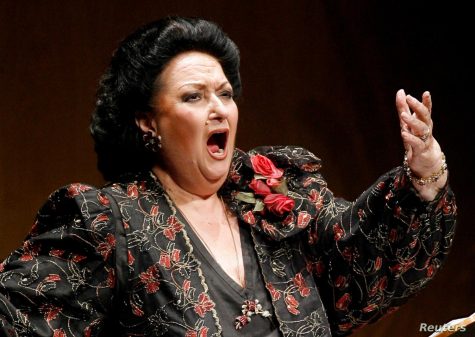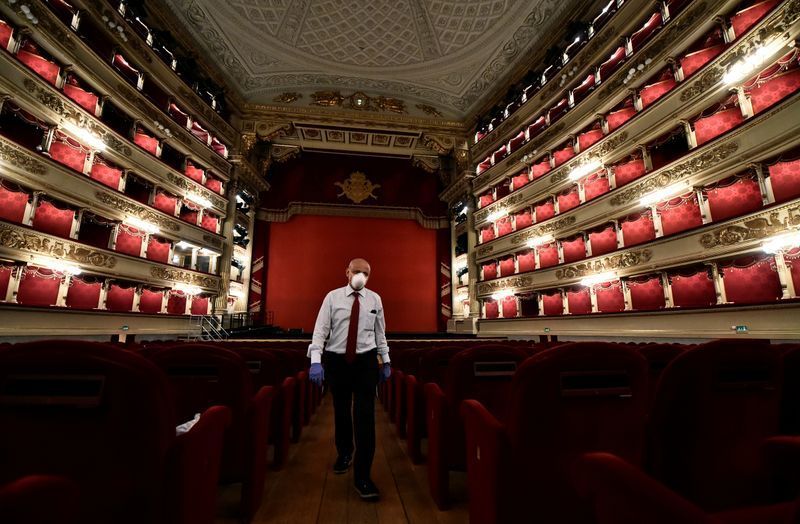What Makes Opera Different From Normal Singing?
FILE PHOTO: A worker walks as Italy’s La Scala opera house reopens to the public for the first time since the coronavirus disease (COVID-19) outbreak, with new social distancing and hygiene rules, in Milan, Italy, June 21, 2020. REUTERS/Flavio Lo Scalzo
During the volatile COVID-19 pandemic today, focusing on the positives and constants of the world can brighten up the world and make everything seem less stuck. One of such positives is opera singing, a beautiful genre of singing that’s been around since 1598. So how does opera singing work? And what makes opera different from normal singing?
Before answering that question, it’s important to know the fundamentals of singing production.
 Our voice box, inside of our larynx, can produce vibrations using mucus membranes. These vibrations determine the pitch of the sound, and our pitch goes higher as our vocal cords vibrate faster. When speaking, our vocal cords vibrate at a lower frequency, about 100-220 hertz, or vibrations per second.
Our voice box, inside of our larynx, can produce vibrations using mucus membranes. These vibrations determine the pitch of the sound, and our pitch goes higher as our vocal cords vibrate faster. When speaking, our vocal cords vibrate at a lower frequency, about 100-220 hertz, or vibrations per second.
Volume is determined by the force applied to your vocal cords when singing (by air pressure and muscle engagement around the vibrator plus using space inside your throat for resonation).
There are also harmonics, which are created during an exhale when air comes up from the lungs and passes through the larynx. When the larynx is closed, the vocal cords will begin to vibrate at multiple different frequencies. The strongest note with the lowest vibration is called the “fundamental pitch,” and it is the main note that you’re singing. Faster vibrations are occurring at the same time, which is called overtones or harmonics. On one note, you sing all of these harmonics, but the higher the harmonic, the less it’s heard. Harmonics vibrate at different speeds than the fundamental pitch, and the higher the vibrations, the higher the pitch. The 2nd harmonic will vibrate twice as fast as the fundamental pitch, the 3rd harmonic will vibrate three times as fast as the fundamental pitch, and so on. You can change the harmonics present in the sound by changing the shape of the vocal folds and, therefore, the pitch being created.
So how do opera singers modify those techniques to master the human voice?
 Opera singers can sing loud enough to be heard over the rest of the orchestra and the other singers without a microphone because their higher pitch and resonation add volume to those higher pitches. To sing higher, opera singers vibrate their vocal cords at somewhere between 250-1,500 hertz, a much higher pitch than other singers or the orchestra. Higher-pitched notes are also more distinct to the human ear. They also create more resonance by using a technique called “resonance tuning.” Since opera singers need to be heard more, they sing their first harmonic above its normal value to match the fundamental frequency and, thus, maintain volume and homogeneity of tone. This is often achieved by opening their mouth wide as if smiling or yawning for high notes, which helps the tract act somewhat like a megaphone
Opera singers can sing loud enough to be heard over the rest of the orchestra and the other singers without a microphone because their higher pitch and resonation add volume to those higher pitches. To sing higher, opera singers vibrate their vocal cords at somewhere between 250-1,500 hertz, a much higher pitch than other singers or the orchestra. Higher-pitched notes are also more distinct to the human ear. They also create more resonance by using a technique called “resonance tuning.” Since opera singers need to be heard more, they sing their first harmonic above its normal value to match the fundamental frequency and, thus, maintain volume and homogeneity of tone. This is often achieved by opening their mouth wide as if smiling or yawning for high notes, which helps the tract act somewhat like a megaphone
They also need to have good note placement; since opera singers don’t have amplifiers with them, they need to amplify their voice using their bodies. They do this with good technique. There are three types of resonance: pharyngeal (like when you say “oh”), nasal (like when you say “ng”), and oral (your regular mouth placement). A different blend of resonances when singing produces a different strength, sound, and volume, with opera singers relying mostly on oral resonance to get that characteristically loud sound.
 Opera singers can’t be tense, seeing as they need to sing for hours upon hours in every concert, for several days a week. Tension in the body, however, born from a lack of breath support or not using the space in the throat properly, takes away breath and energy meant to strengthen the voice and help sing with ease. Therefore, opera singers need to master the basics and complexities of breathing properly and breathe in a way that works for them and is free of tension.
Opera singers can’t be tense, seeing as they need to sing for hours upon hours in every concert, for several days a week. Tension in the body, however, born from a lack of breath support or not using the space in the throat properly, takes away breath and energy meant to strengthen the voice and help sing with ease. Therefore, opera singers need to master the basics and complexities of breathing properly and breathe in a way that works for them and is free of tension.
Opera singing requires a masterful blend of techniques, control, and ease. Achieving this blend requires years upon years of practice. For this reason, the most accomplished opera singers worked for decades until they were able to embody the richness and soul of the opera genre in their singing. So while opera may not be the most popular genre of music today, it is a genre with some of the most talented, hardworking, and technically skilled singers in the world.

Siri Reddy is currently a sophomore. This is her third year attending Keystone. She enjoys listening to music in her free time.


Steve Carter • Dec 10, 2024 at 7:48 pm
Thank you Siri. That was very nice. It inspired my respect for opera singers.